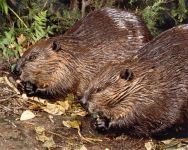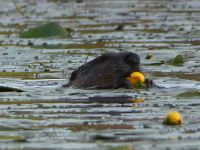


|

|
|
 
|

|
Beaver Tales from Unexpected Wildlife Refuge, October 2019 |
|---|

We are pleased to report that we have received permission to begin construction of our new headquarters, have hired a builder and demolition began in late September! This is a sad occasion because of the numerous wonderful memories attached to the cabin. But, we look forward to the new building to provide better office space and living quarters for our onsite manager, a critical person in keeping the Refuge and its inhabitants safe from harm, such as the beaver shown here, peacefully eating a lily in the main pond a few meters from headquarters. Despite not yet having reached our goal for the funds needed, we felt that we had to start in order to get the outer part of the building done before winter sets in. If you have not already contributed to this important project, we urge you to do so now. We are still in need of funds to ensure that the construction continues without interruptions. If you have already donated, we thank you for your help!
Speaking of an onsite manager for the Refuge, after providing us with exceptional service, Michael sadly had to leave us at the end of August. As a result, we are once again in need of a manager. This is a rewarding and challenging position for a responsible and self-motivated individual who is deeply interested in nature and wildlife and maintaining land as protected natural habitat. Preference will be for a person who is at least a vegetarian and who has practical experience with wildlife or some academic training so that they are knowledgeable about wildlife in general. The manager lives onsite in provided, free accommodations (soon to be in our new headquarters building), including utilities. The diversity of animals and plants provides a rich visual treat for wildlife enthusiasts. The voices of coyotes, eagles, foxes, frogs, owls and many more can be heard throughout the day and evening..